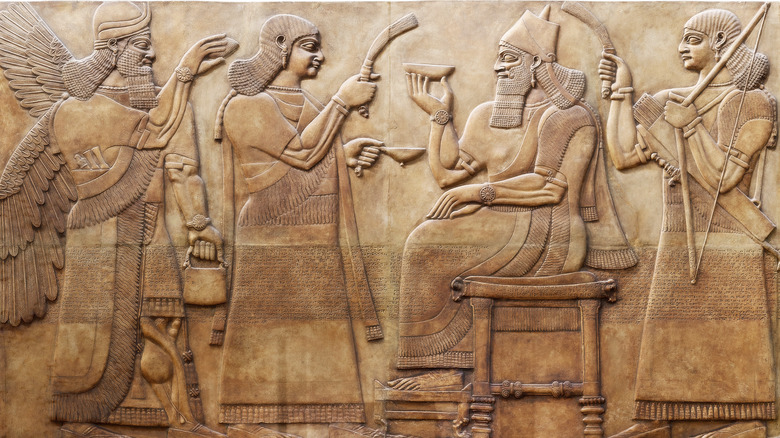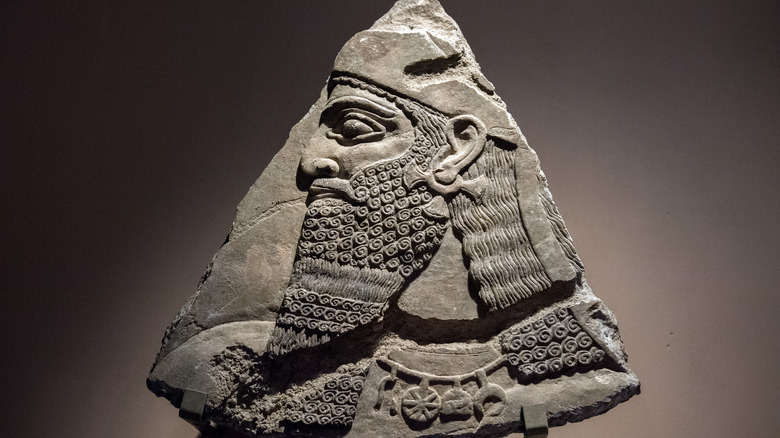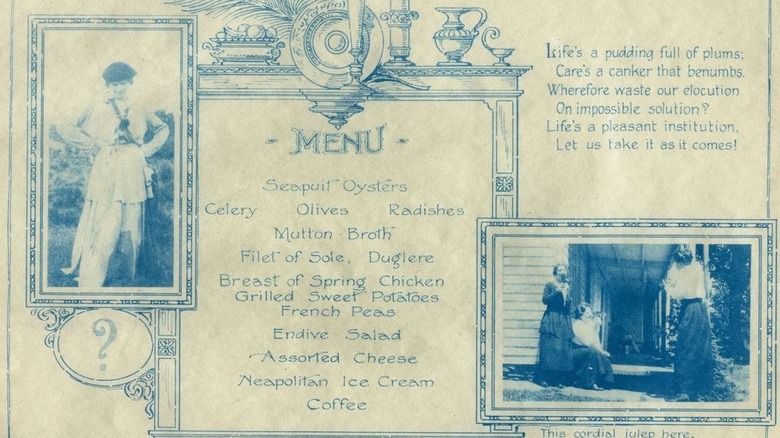The Lavish Palace Feast Behind The World's First Menu
Great parties aren't what they used to be. On the 50th anniversary of celebrated author Truman Capote's star-studded 1966 Black and White Ball at the Plaza Hotel, for instance, The New York Times recalled that it was the "best party ever." That seems pretty hard to believe, given Capote's guest list barely exceeded 500 people. They were the A-listers of their day, of course, but how can a party with so few people be compared to some of the truly epic parties that have taken place throughout recorded history?
Neo-Assyrian monarch Ashurnasirpal II's legendary banquet feast in Kalhu in 879 B.C., for example, featured nearly 70,000 guests, including the A-listers of the time. In fact, the entire nation attended. Capote, by contrast, barely got a building's worth of Manhattan residents. It wasn't just the enormous turnout that made Ashurnasirpal II's party so epic, however. This banquet raged for a full 10 days and saw more than 10,000 "measures" of beer and 10,000 "containers" of wine consumed, as described by the World History Encyclopedia — not to mention 14,000 sheep, 10,000 fish, and 10,000 eggs. Those food items were barely a fraction of what was on the menu, it should be noted, and nowadays that menu is why this feast is still remembered.
Ashurnasirpal II's so-called Banquet Stele — or the menu carved into stone for a four-ton recounting of the bill of fare enjoyed by his party guests, is considered the first recorded instance of a menu in human history. As such, it's the earliest antecedent of modern restaurant menus.
The Banquet Stele and its menu items
The Banquet Stele was lost for thousands of years before being discovered again by archaeologists working in modern-day Iraq in 1951. Ashurnasirpal II, it turns out, didn't just recount what he fed the guests at his legendary Kalhu feast, but also his many other great achievements, the totality of which were carved in ancient Akkadian cuneiform script on enormous stone tablets, and displayed at his newly unveiled palace.
This palace had already been built when Ashurnasirpal II hosted his legendary banquet feast in 879 B.C, and its construction — as well as the accompanying city of Kalhu — probably provided the reason for the celebratory feast, although the king's motivation for such a mammoth undertaking is still debated by contemporary historians. Perhaps he just wanted to trumpet his own magnificence. The Banquet Stele, for example, spares no details in terms of the party's outlandish extravagance. In addition to the thousands of servings of beer and wine, there were also many thousands of oxen, sheep, and cattle slain for the feast, as well as some 500 game birds, and an equal number of presumably delicious gazelle.
The Banquet Stele has provided a treasure trove for modern food historians, from the meat and fish courses to the many other ingredients Ashurnasirpal II considered feast-worthy. These included cheese and nuts; regional fruits like dates, grapes, and olives; and, of course, plenty of milk and honey.
The first menu compared to those that followed
Although it is considered the first menu in history, Ashurnasirpal II's Banquet Stele has little resemblance to a modern menu in that it wasn't something guests could peruse for the purpose of ordering food and drinks. Rather, it was simply a literal recounting of everything the king fed to his many partygoers — and in what quantities — interspersed with lines about how great he was, and how much the gods had favored him.
For most of human history, diners were treated to whatever food items a tavern, inn, or other eatery had prepared for them that day. The first menus, as the term is now understood, weren't introduced until the 12th century Song Dynasty in China when early restaurant-style eateries in Hangzhou and Kaifeng first showcased lists of available dishes. Meanwhile, paper menus didn't become popular for another six centuries, and then only in Paris.
In the U.S., the first à la carte restaurant menu is thought to have originated at Delmonico's, the iconic New York City landmark that opened, in its first incarnation, on William Street in 1827. The restaurant's oldest surviving menu dates to 1838, with offerings that included modest dishes like mutton stew, and liver and bacon. By the end of the 19th century, however, Delmonico's had created several classic American dishes — Eggs Benedict and Baked Alaska, notably — and had also expanded service to accommodate signature 14-course dinners. Ashurnasirpal II would probably have appreciated the extravagance.



